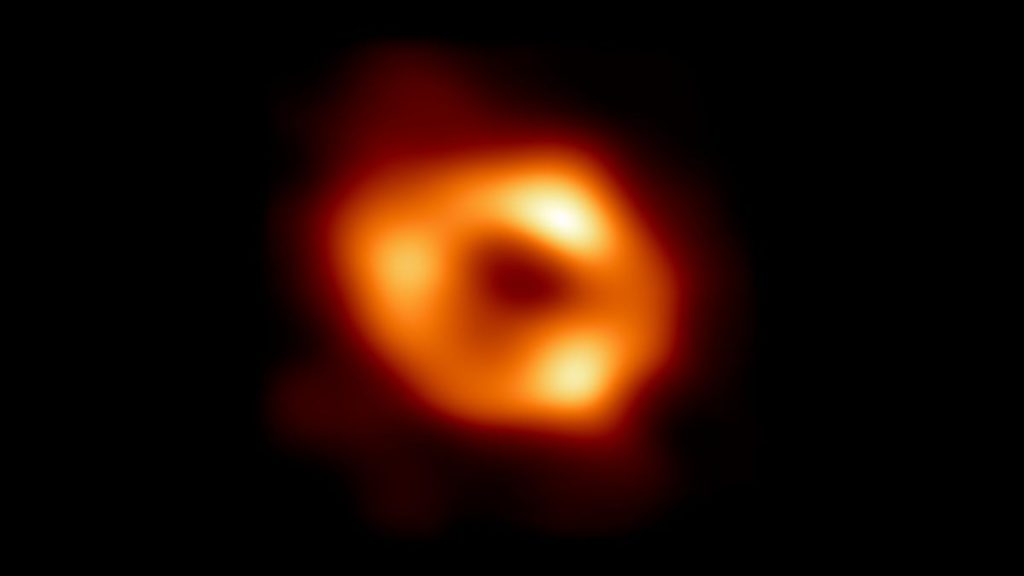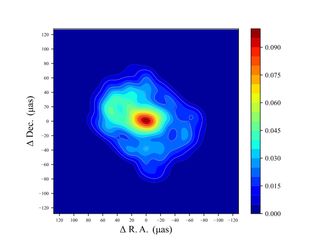
1st image of our Milky Way’s black hole may be inaccurate, scientists say (Image Credit: Space.com)
What does the supermassive black hole lurking at the center of our galaxy look like?It’s a deceptively simple question.
Although our local cosmic abyss, named Sgr A* (short for Sagittarius A*), resides just 26,000 light-years from Earth, it has proven to be a very difficult object to image. This is thanks in part to material whipping around it at near light-speeds. However, after years of trying, scientists with the Event Horizon Telescope (EHT) project succeeded in 2022.The black hole’s silhouette emerged from the shadows, appearing like a fuzzy orange doughnut.
Yet now, an independent analysis of the EHT data suggests part of the image’s doughnut-like appearance may be an artifact due to the way it was put together. This discovery owes itself to a trio of scientists at the National Astronomical Observatory of Japan (NAOJ).
The ring-like structure, which really represents intense radio waves blasted from the brilliant disk of gas, known as the “accretion disk,” that’s swirling around the black hole, may in fact be more elongated than appears, the researchers argue.
“No telescope can capture an astronomical image perfectly,” Makoto Miyoshi of NAOJ, who led the latest analysis of EHT data, said in a recent statement. “We hypothesize that the ring image resulted from errors during EHT’s imaging analysis and that part of it was an artifact, rather than the actual astronomical structure.”
The EHT consortium has so far made no official statements about the topic.
More than 400 researchers from 13 institutions, including the NAOJ, constitute the EHT’s international consortium, which operates a growing network of telescopes around the world to form one virtual, Earth-sized telescope using a technique called Very Long Baseline interferometry. Two EHT scientists note in a 2022 interview that gaps in data were expected due to EHT operating just eight telescopes in six locations around the world.
Katie Bouman, an assistant professor at the California Institute of Technology, likened the limited information being gathered to “listening to a song from a piano where many of the keys are missing.”
The EHT project made history in 2019 when it unveiled the first-ever image of a black hole, marking a technological breakthrough that brought to light the silhouette of the elusive cosmic beast residing at the heart of the M87 galaxy.
The project was simultaneously scrutinizing Sgr A*, which proved tough to image because it is 1,600 times lighter than the M87 behemoth, which means material that takes weeks to travel around M87* zipped around Sgr A* within minutes.
“Sgr A* is like a toddler who can’t stay standing still while we are taking its photo over the course of a night,” Bouman said in the 2022 news release, which sought to outline scientists’ effort to image the two black holes.
The task was made tougher by thick clouds of dust and gas hovering between Earth and the Galactic Center that distorted and blurred radio signals coming from Sgr A*, she added. So, the EHT collaboration used special computer algorithms that could fill in gaps in data caused by the widely separated telescopes. From there, the team reconstructed the image prior to the chaos caused by the turbulent gas.
“Each algorithm has its own method for determining which image is most likely,” said Bouman. “It is a bit like hiring Sherlock Holmes, Hercule Poirot, Jane Marple and Jules Maigret simultaneously to see what they commonly conclude and what they don’t.”
Based on thousands of images that captured how the black hole’s appearance changed across multiple observing nights, the vast majority of the computer simulations depicted a bright ring of light as big as the orbit of Mercury, in agreement with predictions from Albert Einstein’s theory of general relativity.
In the new study, Miyoshi and colleagues specifically argue this ring-like structure is an artifact caused by the bumpy point-spread function (PSF), which refers to the way an imaging system measures the amount of blurring caused by gaps in data.
The researchers applied what they termed “widely-used traditional” analysis methods to the EHT data that are different from the EHT’s own original analysis method. The results showed the accretion disk to be slightly elongated in the east-west direction, the team wrote in their paper. published in the journal Monthly Notices of the Royal Astronomical Society.
The new image also shows the disk’s eastern half to be brighter than the western half, which the researchers interpret as a Doppler boost, meaning the east side is moving toward us.
“We think this appearance means the accretion disk surrounding the black hole is rotating at about 60% of the speed of light,” said Miyoshi.
For now, either view of the disk’s real shape could be correct. Astronomers say forthcoming technological upgrades to telescopes will allow them to gather more detailed images and better constrain the area around Sgr A* and other black holes.
The paper about these results was published this year in the journal Monthly Notices of the Royal Astronomical Society.






